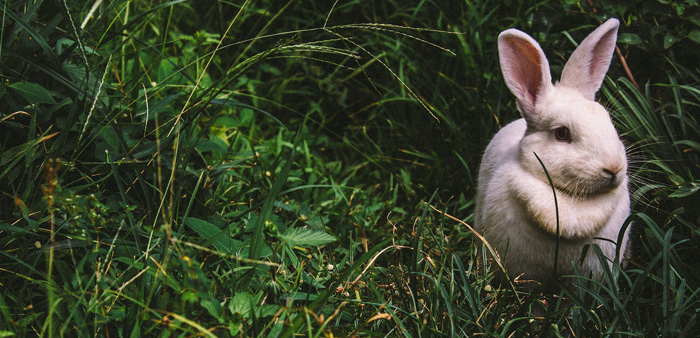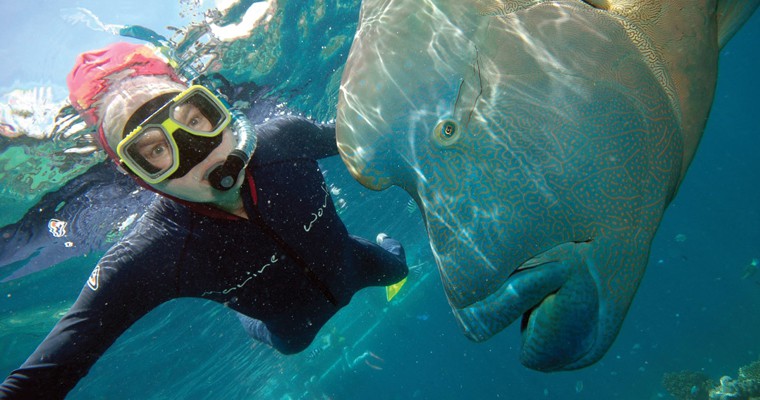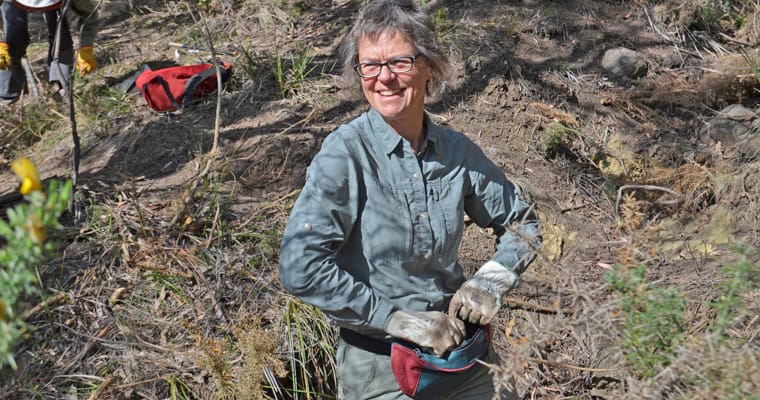
A call to let Australia’s feral rabbits roam free without any form of human intervention set adjunct professor Peter Fleming to thinking. Is the ‘Compassionate Conservation’ movement a fair, ecologically founded approach to managing harmful invasive species, or misguided and misplaced compassion?
Compassionate Conservation is proposed as “a rapidly growing international and cross-disciplinary movement that promotes the protection of wild animals as individuals within conservation practice and policy”.
Although a noble and admirable ideal, unfortunately, respecting the rights of one individual or group of animals may involve trampling on the rights of others. Invasive animals do exactly that, often with catastrophic effects on the survival of other animal and plant species, and completely restructuring ecosystems. Often humans have to kill individuals of one species to achieve conservation of broader intrinsic, economic and environmental values.
When the Compassionate Conservationists call for European wild rabbits to be left alone for compassion’s sake conservation biologists and the wider community need to take a stand. Rabbits are a main player in the degradation of Australian ecosystems. I use rabbits as a case study to show that being “compassionate” to the individual animal has individual and population consequences for small mammals and plant regeneration. This leads to homogenisation and degradation of Australian ecosystems. Doing nothing or relying on introduced predators to do the job for us cannot diminish rabbit population growth rates or reduce the population density below environmentally damaging thresholds.
The 3rd International Compassionate Conservation Conference was held in Leura, NSW, November 2017 with the objective of setting an agenda for wildlife conservation into the future. Talks included reasons why we don’t need to kill for conservation, the welfare of wild animals, predator-friendly farming, law changes for compassionate conservation of wildlife and, most surprising to an ecologist like me, how nature benefits from alien species. Having spent a career trying to undo the damage caused by invasive introduced animals to our Australasian environmental and agricultural values, this set me thinking. I presented a first draft of those thoughts at the Vertebrate Pest Conference in Canberra last year. This is where my thinking is up to.
What is compassion?
Compassion is derived from the Latin compassio, which translates as ‘sympathy’. It is a feeling or show of sympathy and concern for others. The Macquarie Dictionary defines compassion as “a feeling of sorrow or pity for the sufferings or misfortunes of another; sympathy”. It is by people towards other people, but is often for and to other living things, too. This expression of sympathy is particularly so for sentient animals or at least those with the neural pathways that correlate with self-awareness and consciousness in humans (e.g. Parvizi et al. 2006; Damasio and Meyer 2008). The pathways in our brains for admiration and compassion have recently been determined (e.g. Immordino-Yang et al. 2009) and so it is technically plausible that similar pathways could be investigated in other mammals. However, as far as we can ascertain, compassion is a purely human characteristic.
What is conservation?
There are two components to conservation, the actions people undertake and the underlying philosophy that drives them to do it.
We carry out conservation by managing nature to protect species, their habitats and ecosystems from decline and extinction. The science of conservation biology examines the biological processes that underlie the retention, restoration and recovery of species, populations, communities and ecosystems. Although welfare considerations influence conservation practices, wildlife conservation is reliant on the ecology of populations and their communities, not on individual animal welfare. Individual animal welfare is usually inconsequential for the wildlife conservation outcomes of management.
Underlying the activities and studies of biological conservation is “a philosophy of managing the environment in a manner that does not despoil, exhaust or extinguish” (Jordan 1995). It is an ethic of proper use of natural resources to maintain the health of the globe and retain biodiversity.
What is Compassionate Conservation?
According to the UTS website, Compassionate Conservation is “a morally grounded approach to resolving land sharing issues by utilising the universal ethic of compassion to alleviate suffering in humans and other animals”. The site describes Compassionate Conservationists as people who “are concerned with the protection and well-being of individual wild animals (whether free-roaming or captive), reshaping the framework of traditional conservation biology that has its roots in species, populations and ecosystems.”
Compassionate Conservationists have compassion and are driven by a caring philosophy, but they are not the only ones. I think most would agree with many of the goals of compassionate conservationists and the first part of Marc Bekoff’s statement on the website: “Compassion for animals should be fundamental for conservation because poor conservation outcomes are often consistent with the mistreatment of animals”. Ecologists should take issue with the second clause: there is often no correlation between mistreatment of animals and poor conservation outcomes. These mostly occur without people directly interacting with animals; for example, the killing of endangered animals by invasive predators and the starvation of animals caused by rabbits degrading their habitat.
Compassionate Conservationists cannot usurp the moral high ground by implying, as they do in their self-descriptions, that those who reject their laissez faire approach to invasive animal management are uncaring and somehow morally inferior.
The approach of Compassionate Conservation is not always compassionate. The survival of an individual animal always depends on the death of or damage to individuals of other species (competitors, prey, plants). That is called Nature, which is “red in tooth and claw” (Alfred, Lord Tennyson (1850) in In Memoriam A.H.H.).
Compassionate Conservationists often suggest we should outsource the killing of invasive animals to other animals, for example leaving control of invasive prey animals to predators such as dingoes and feral cats (https://theconversation.com/lets-give-feral-cats-their-citizenship-45165). The suggestion that allowing predators that endanger the very existence of other animal species to live because of compassion towards them as individuals lacks compassion to the animals they prey upon. This approach is not equally compassionate to all animals. There is a value judgement as to which animal deserves more compassion, which should be protected and which animal should take their chances with the introduced predator extinction steamroller.
Compassionate Conservation usually cannot conserve
Concentrating on the individual has no influence on conservation outcomes unless that individual is considered as a member of its population. Excepting very small or declining populations, protecting the individual has no effect on the conservation status or well-being of individuals within species, populations or communities. And, because of the small population syndrome, most small populations are doomed anyway (Bradshaw 2018). Individuals live or die; populations and ecosystems survive, prosper or become extinct.
If we wish to slow or reverse the extinction trends among predator-affected Australasian wildlife, we have no choice but to reduce the populations of invasive animals by killing individuals. The claims that guardian animals or dingoes will do the job without affecting the welfare of other individual animals are naïve or misleading. If we rely on a third party to do our killing or harassing, we are just as guilty or responsible as the killer. Outsourcing is not a more moral stance than taking responsibility for cleaning up the ecological mess our forebears purposely, but unwittingly, made.
Compassionate Conservation starts with “do no harm”. This is an admirable objective, similar to the principle underlying medical practice, but what if doing no harm to one animal directly or indirectly causes harm to another living thing? This will always happen while predators kill and eat prey and herbivores eat plants. Doing no harm to the individual animal is often taken to mean doing nothing at all, which has individual and population consequences, including extinction. Showing compassion does not equate to taking no action – neither is doing nothing a compassionate response to environmental tribulation.
In Compassionate Conservation, welfare and survival (i.e. morbidity & mortality) of the individual are confused with survival of the population (i.e. conservation or extinction). Conservation of a species, population, community or ecosystem relies on a positive or neutral rate of increase, that is, replacement must be equal to or greater than deaths. The identity, welfare and survival of a single individual animal are irrelevant to this.
Rabbits are not welcome additions to Australian fauna
European wild rabbits are beautiful animals. Rabbits are also unquestionably a main player in degradation and destruction of Australian ecosystems and thereby a driver of suffering for countless other animals.
One of the Compassionate Conservationists has suggested we leave rabbits alone and, indeed, welcome them. Arian Wallach, Centre for Compassionate Conservation, University of Technology, Sydney, wrote in response to Andrew Bengsen (2014) in The Conversation:
“Christmas could also provide an opportunity for growing a more compassionate response to introduced species. Killing rabbits, and other unwanted species, has not provided the cure to Australia’s environmental problems, because ultimately these problems are of our own making. Persecution of Australia’s apex predator, the dingo, alongside other human activities such as overgrazing with livestock, have been highly detrimental. Rabbits are merely the scapegoat. Dingoes, particularly when socially stable, can limit rabbit densities. Providing space for dingoes to assume their ecological function offers a way forward that is both effective and ethical. It is also important to consider that rabbits are a threatened species in their native range, and they provide many ecological benefits – not just harms. 1859 may indeed have been a Christmas gift we can be grateful for.”
This is untrue on many levels. For a start, killing many rabbits has been shown to be the only effective way of limiting their ecological and agricultural damage (Saunders and McLeod 2014). The release of myxoma virus in the 1950s and rabbit haemorrhagic disease in the 1990s and last year, both of which killed millions of rabbits, and ongoing poisoning, ripping and shooting have resulted in 20 years of vegetation restoration and saved endangered mammals (Pedler et al. 2016). The reason for this is simple. Peter Bird, Greg Mutze and colleagues in South Australia have shown that rabbits in extremely low densities (equivalent to less than 1 rabbit in an area the size of Adelaide Oval) prevent recruitment of some species including coastal she-oak, which is the structural backbone of the fragile, coastal ecosystem in which they occur. Without recruitment, no regeneration is possible and the ecosystem changes, affecting all the animals that are part of that system. This is slow-death ecosystem engineering on a massive scale.
When the Compassionate Conservationists call for rabbits to be left alone, and some researchers support these calls, it behoves ecologists and conservationists to take a stand. Doing nothing and relying on introduced predators to suppress rabbits for us cannot push rabbit population growth below zero, nor reduce the population density below damage thresholds. This is like sending a child to do an adult’s job. Dingoes, socially stable or otherwise, have never been shown to even limit, let alone diminish, rabbit populations. Predators (foxes and cats) have only been shown to limit rabbits after rabbit numbers have been decimated by drought (Pech et al. 1992). As soon as it rains and pasture grows, the rabbits, which have evolved to breed like, well, rabbits, do so, and rapidly outstrip the predators who breed far less often. The idea that dingoes, which naturally exist at much lower densities than rabbits, can be more effective in reducing rabbit populations than human-introduced biocontrol and traditional killing methods, doesn’t stack up. Rabbits are endangered in their native environment, but that is not Australasia. To do nothing here in the name of welfare or rights of individual rabbits, or outsourcing rabbit control to predators, is an abrogation of our responsibility to care for and conserve our environments.
A note on terminology
Speciation and extinction are happening all the time, but humans are accelerating the latter through massive changes by the introduction of species from different ecosystems. Those that succeed and establish to the detriment of agricultural and environmental values are considered “invasive”. This is a descriptive term, not a denigrating or militaristic term as claimed by some proponents of Compassionate Conservation at the Leura conference. For example, terming pest animals “non-human animal overflows” (Hillier 2017) or “non-human overflow beings”, might be descriptive if “overflow” is subsequently defined in a non-aqueous context, but they are hardly succinct terms. “Invasive” is better than “pest” because it signals that what they do has negative impacts rather than identifying the species itself as pestilent. It is fine to take issue with terminology, but criticism is only useful if effective alternatives are proposed. To date, no succinct, descriptive, useful or accurate alternatives to “invasive” have been proffered.
Conclusion
It would be safe to assume that most conservationists are compassionate – without compassion for the living world they would not be interested in conserving it.
Compassionate Conservation has the capacity to do harm to the cause of conservation in Australia and elsewhere because it has little foundation in biology. It is animal liberation dressed up as conservation science.
Sometimes it is more ethical to kill animals than not to. Conservation of individuals, species and ecosystems often depends on that ethic. When you must kill individuals of one species to preserve the very existence of another species and prevent it from careering or staggering to extinction, it is a moral act. To stand by and watch extinction happen in the guise of compassion is reprehensible.
Graeme Caughley was quoted by Hugh Tyndale-Biscoe in his citation to Graeme on his admission to the Australian Academy of Science Fellowship.
“I have no strong feeling for individual wild animals although paradoxically I cried when the family cat was run over. I get very emotional about the suggestion that a population of wild animals should be exterminated. Hence I am a conservationist but not an animal-liberationist.”
Graeme was talking about the natural fauna of the countries he worked in, not the management of invasive species that threatened their existence. I would add that I get very emotional about the suggestion that populations of Australia’s unique fauna should be exterminated by invasive species overseen by people’s inactivity masquerading as caring or animal rights. I am a lower case compassionate conservationist (i.e. a conservationist with compassion), but I am a living animal and every meal I eat compromises the life of another animal or plant. All things come with a cost, so I guess I’ll just have to get used to it: “Such is Life”.
About the author
Peter is an ecologist who works on the biology, ecology and management of invasive predators and their prey. He is Adjunct Professor of Ecosystem Management, University of New England and Principal Research Scientist with NSW Department of Primary Industries.
Acknowledgements
Guy Ballard, Andrew Bengsen, Tarnya Cox, Greg Mutze (Co-authors of the presentation to the 17th Vertebrate Pest Conference) and Karl Vernes contributed useful ideas to this article. Peter Fleming is a long-term member of the Birdlife Australia, the Australian Mammal Society and the Australasian Wildlife Management Society. The opinions expressed here are his own.
References
Bengsen, A. (2014), “The rabbits of Christmas past: a present that backfired for Australia.” The Conversation 22/12/2014 (https://theconversation.com/the-rabbits-of-christmas-past-a-present-that-backfired-for-australia-35544).
Bradshaw, C. (2018) “Even if you were the last rhino on Earth… why populations can’t be saved by a single breeding pair”. The Conversation 22/03/2018 (https://theconversation.com/even-if-you-were-the-last-rhino-on-earth-why-populations-cant-be-saved-by-a-single-breeding-pair-93733).
Damasio, A. and Meyer, K. (2008) Behind the looking-glass. Nature 454, 167.
Frith, H.J. (1973) Wildlife Conservation. (Angus and Robinson: Sydney).
Hillier, Jean (2017) No place to go? Management of non-human animal overflows in Australia. European Management Journal 35, 712-721.
Immordino-Yang, Mary Helen, McColl, Andrea, Damasio, Hanna and Damasio, Antonio (2009) Neural correlates of admiration and compassion. Proceedings of the National Academy of Sciences 106, 8021.
Jordan, C.F (1995) Conservation: Replacing Quantity with Quality as a Goal for Global Management. (Wiley: New York).
Parvizi, J., Van Hoesen, G.W., Buckwalter, J. and Damasio, A. (2006) Neural connections of the posteromedial cortex in the macaque. Proceedings of the National Academy of Sciences 103, 1563.
Pedler, R.D., Brandle, R., Read, J.L., Southgate, R., Bird, P. and Moseby, K.E. (2016) Rabbit biocontrol and landscape-scale recovery of threatened desert mammals. Conservation Biology 30, 774-782.
Saunders, G. and McLeod, S.R. (2014) The European rabbit: Australia’s worst mammalian invader. Pp. 429-451 In. (Eds H.H.T. Prins and I.J. Gordon) Invasion biology and ecological theory: insights from a continent in transformation. (Cambridge University Press: Cambridge, UK).
Tyndale-Biscoe, C.H. (1999) Graeme James Caughley 1937-1994. Historical Records of Australian Science, 12 (3) (https://www.science.org.au/fellowship/fellows/biographical-memoirs/graeme-james-caughley-1937-1994).




